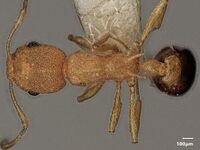Cardiocondyla goroka
| Cardiocondyla goroka | |
|---|---|

| |
| Scientific classification | |
| Kingdom: | Animalia |
| Phylum: | Arthropoda |
| Class: | Insecta |
| Order: | Hymenoptera |
| Family: | Formicidae |
| Subfamily: | Myrmicinae |
| Tribe: | Crematogastrini |
| Genus: | Cardiocondyla |
| Species: | C. goroka |
| Binomial name | |
| Cardiocondyla goroka Seifert, 2022 | |
This species is known from a handful of collections from Papua New Guinea. One forager was collected by P.S. Ward in a cleared grassy area.
Identification
Worker (Figure 20, images of specimen CASENT0914971 in www.antweb.org, Table 4): much larger than Cardiocondyla wheeleri and C. excavata, CS 590 µm. Head rather short, CL/CW 1.145, occipital margin straight or slightly excavated, anterior clypeal margin slightly excavated, depth of excavation 0.7–1.0% CL. Postocular distance large, PoOc/CL 0.432. Scape rather long, SL/CS 0.870. Eye small, EYE/CS 0.225. Frons rather narrow (FRS/CS 0.283), frontal carinae immediately caudal of the FRS level parallel or weakly converging caudad and then diverging. Pronotal corners in dorsal view prominent, but blunt, forming an angle of 90–95°. Dorsal plane of mesosoma not continuously narrowing from pronotal corners caudal to metanotal groove, margin caudal of pronotal corners first concave and then convex; in contrast to C. wheeleri, there is a conspicuous convexity at the mesonotal level. Metanotal depression moderately deep and with shallow slopes. Spines strong, straight or downcurved but shorter than in C. wheeleri and C. excavata (SP/CS 0.332) and with a large basal distance (SPBA/CS 0.370); in lateral view more erected than in C. wheeleri and C. excavata, chord of spine base and tip deviating by 17–22° from longitudinal mesosomal axis. Petiole rather wide and high (PeW/CS 0.284, PeH/CS 0.351), the peduncle longer and the anterior profile more concave than in C. wheeleri, dorsal profile broadly convex; the node in dorsal view globular. Postpetiole in dorsal view broad (PpW/CS 0.524) but relatively narrower than in C. wheeleri, with semicircularly rounded sides and strongly concave anterior margin; in lateral view much lower than petiole (PpH/CS 0.280), its sternite shallowly convex and without any prominent structures. Whole dorsal head in overall impression matt. A narrow stripe on median vertex, frontal laminae, and posterior half of clypeus longitudinally carinulate. Paramedian and lateral vertex with bicoronate foveolae of 15–18 µm diameter which are deeper and more eye-catching than in C. wheeleri; foveolae embedded between longitudinal rugulae, foveolar interspaces smaller or as wide as foveolar diameter. Mesosoma matt, entirely microreticulate-foveolate-corrugated. Petiole moderately shiny and microreticulate. Postpetiole dorsally moderately shiny and finely microreticulate. Gaster tergites moderately shiny, delicately microreticulate. Tergite pubescence short and denser than in C. wheeleri (PLG/CS 4.25%, sqPDG 5.34). Whole body except of the blackish gaster and the infuscated antennal club yellowish.
Cardiocondyla goroka is hypothesized here as a sister species of Cardiocondyla wheeleri. Considering the situation in Cardiocondyla species worldwide, the large difference in absolute body size to C. wheeleri and C. excavata is unlikely to be explained by intraspecific variance. Furthermore the differing dorsal aspect of mesosoma, spine orientation and length seem better explained by heterospecificity than by intraspecific variation.
Keys including this Species
Distribution
Latitudinal Distribution Pattern
Latitudinal Range: -6.0° to -7.4°.
| North Temperate |
North Subtropical |
Tropical | South Subtropical |
South Temperate |
- Source: Seifert, 2022
Distribution based on Regional Taxon Lists
Indo-Australian Region: New Guinea.
Distribution based on AntMaps
Distribution based on AntWeb specimens
Check data from AntWeb
Countries Occupied
| Number of countries occupied by this species based on AntWiki Regional Taxon Lists. In general, fewer countries occupied indicates a narrower range, while more countries indicates a more widespread species. |

|
Estimated Abundance
| Relative abundance based on number of AntMaps records per species (this species within the purple bar). Fewer records (to the left) indicates a less abundant/encountered species while more records (to the right) indicates more abundant/encountered species. |

|
Biology
Castes
Nomenclature
The following information is derived from Barry Bolton's Online Catalogue of the Ants of the World.
- goroka. Cardiocondyla goroka Seifert, 2022: 50, fig. 20 (w.) PAPUA NEW GUINEA.
Type Material
Holotype worker labelled “PAPUA N.G. Rihona, betw. Goroka and Markham Riv.\1980 R.I.Vane-Wright”, depository BMNH London; one paratype worker labelled “NEW GUINEA: Morobe district, Wau, Mt. Kaindi, alt. 2200m 25-II-1973 Thomas W. Davies”, depository CAS San Francisco; one paratype worker labelled “ PNG: 7.356° S, 146.678° E, Wau: Mt. Kaindi, 2200 m,B.B. Lowery 1967.12.13”, depository SMN Görlitz.

